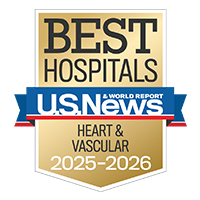Eisenmenger's Syndrome

Overview
Eisenmenger's syndrome, which is named after the doctor who first described it, is a combination of two conditions. First, it involves having a communication, or hole, between two cardiac chambers that allows oxygenated blood to recirculate back into the right ventricle and to the lungs instead of flowing out of the left ventricle to the rest of the body. Over time, this extra blood flow to the lungs damages their vessels, causing high pressures or pulmonary hypertension that reverses the flow of blood, so the deoxygenated blood goes out to the rest of the body. Eisenmenger's syndrome refers to this combination of reversed blood flow with pulmonary hypertension. It results in cyanosis or low oxygen content in the blood and may eventually result in failure of the right ventricle. However, many patients live well into adulthood with the proper care.
The hole may be a ventricular septal defect, an atrial septal defect or a patent ductus arteriosus. A baby born with a single ventricle also may develop this condition.
Our approach to Eisenmenger's syndrome
UCSF provides comprehensive, highly specialized care for adults living with heart defects such as Eisenmenger's syndrome. Our dedicated team of experts offers a wide array of services, including thorough medical evaluations, advanced treatments, long-term monitoring, and personalized recommendations on diet, exercise and psychosocial support. For patients who need transplantation, UCSF is also home to high-performing heart and lung transplant programs.
Awards & recognition
-

Among the top hospitals in the nation
-

One of the nation's best for heart & vascular care
Signs & symptoms
Signs and symptoms of Eisenmenger's syndrome include:
- Cyanosis, a blue tinge to the skin resulting from lack of oxygen
- High red blood cell count
- Swollen or clubbed finger tips
- Fainting, called syncope
- Heart failure
- Arrhythmia or irregular heart rhythms
- Bleeding disorders
- Coughing up blood
- Iron deficiency
- Kidney problems
- Stroke
- Gout
- Gallstones
Diagnosis
An echocardiogram usually will show the defect and can measure the pressure in the right ventricle and the lungs. Heart catheterization, a procedure in which a narrow flexible tube called a catheter is threaded through the blood vessels into the heart, may be used to determine the size of the hole and to measure pressure within the heart.
Treatments
Routine cardiac medications may have more side effects in patients with Eisenmenger's syndrome and should be prescribed with great caution. Your doctor also may suggest removing some blood a couple of times a year to reduce the amount of red blood cells, but this should only be done when there are symptoms if your blood count is extremely high. The survival rate for people with Eisenmenger's syndrome at age 25 is 42 percent.
Adult patients with Eisenmenger's syndrome should be seen by a cardiologist specializing in the care of adults with congenital heart disease to monitor for late complications. All patients will need to take antibiotics during subsequent surgeries or dental procedures to protect against endocarditis. Pregnancy and childbirth are extremely hazardous in women who have Eisenmenger's; they should not get pregnant but must choose contraception carefully to avoid blood pressure problems.
It is important to eat a nutritious diet and avoid alcohol and salt. Overexertion and smoking also should be avoided. Surgery that is used to repair the defect can't be used after pulmonary hypertension has developed because the change in blood pressure would further damage the heart. The only other surgical option is heart/lung transplant or lung transplant along with a repair of the defect.
UCSF Health medical specialists have reviewed this information. It is for educational purposes only and is not intended to replace the advice of your doctor or other health care provider. We encourage you to discuss any questions or concerns you may have with your provider.












